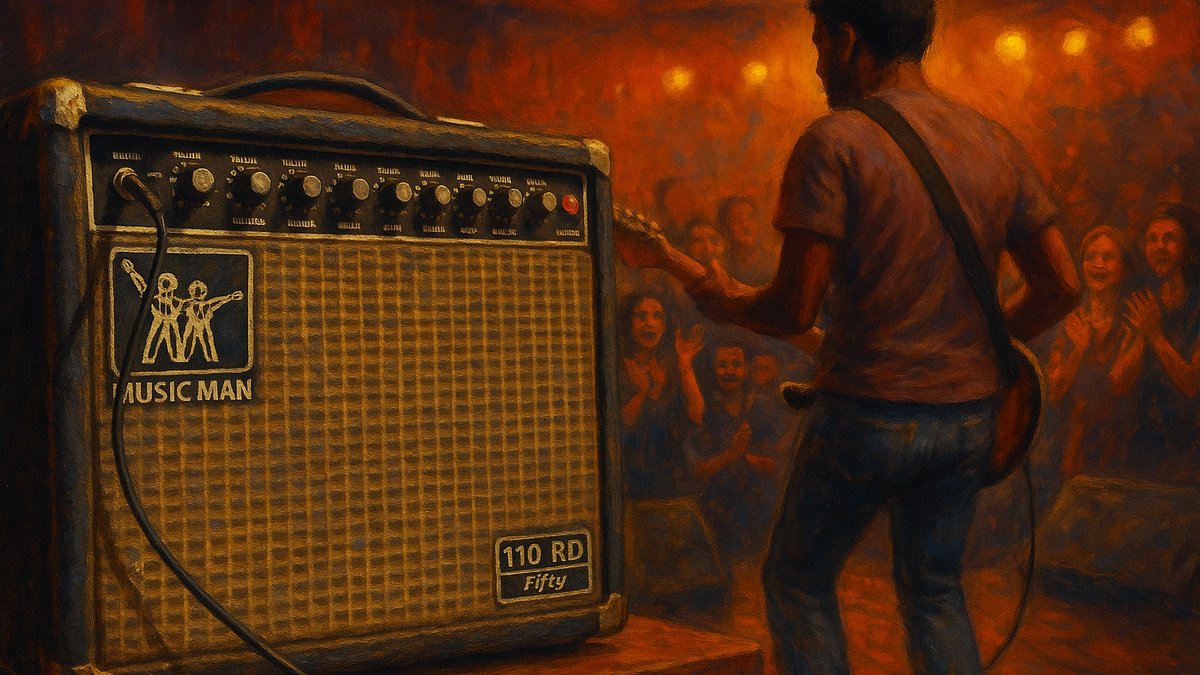
By Kevin Chisholm
Posted 05/21/2025
The Music Man 110 RD 50 may not be the first amp that jumps to mind when you think of compact gigging powerhouses, but for those in the know, it has long held a reputation as one of the most underrated gems of the early ’80s. With a chiming clean tone that stands shoulder to shoulder with the mighty Fender Deluxe Reverb—and at a fraction of the size—it’s no wonder I’ve owned more than a few of these over the years.
The 110 RD 50, introduced around 1981, was part of that lineage. Featuring a single 10″ speaker and housed in a rugged black Tolex cabinet, the amp was designed to be a workhorse for players who needed clean volume and reliability in a tight space—especially useful in cramped club stages or studio settings. The “RD” designation made it clear that this wasn’t just a clean machine; Music Man aimed to offer a built-in lead tone with onboard distortion as well.
Music Man 110 RD 50 Technical Details
- Power Output: 50 watts RMS
- Speaker: 1×10″ ceramic magnet speaker (stock)
- Preamp: Solid-state with a 12AX7 phase inverter
- Power Amp: 2×6L6GC tubes
- Controls: Volume, Treble, Bass (per channel), Reverb, and Gain
- Channels: Single channel with footswitchable “Limiter” (lead/distortion mode)
- Features: Built-in spring reverb, 2-button footswitch jack (Reverb and Limiter)
- Weight: Approximately 35 lbs
- Production Years: 1981–1983
My Personal Thoughts About the Music Man 110 RD 50
I’ve owned five or six of these over the years, and I keep coming back to them for one simple reason: they just work. The clean tone is crisp, open, and full of chime—remarkably close to the legendary Fender Deluxe Reverb. But here’s the kicker: the Music Man 110 RD 50 is about half the size and easily more than twice as loud.
This amp takes pedals like a champ. I’ve run everything from transparent overdrives to gnarly fuzzes through it, and it never flinches. You can really push the front end with a stompbox and be surprised at how monstrous this little combo can sound.
In terms of volume, this thing is a wolf in sheep’s clothing. The 50-watt output through a 10″ speaker delivers astonishing headroom and projection. The 112 version with its 12″ speaker can push even more air, but the 110 is easier to haul and fits better on tight stages.
For years, this was my “go-to” gigging amp in New York City. Whether I was subway-hopping with a handcart or squeezing onto a stage the size of a postage stamp, it struck the perfect balance between portability and power. It’s also bulletproof—never once did I have a single issue with it on stage. The built-in spring reverb is no slouch either. While not quite as lush as a vintage Fender tank, it holds its own and adds great ambience to your tone.
Downsides of the Music Man 110 RD 50
Let’s be honest—the “Lead” channel, also labeled “Limiter,” leaves something to be desired. If you’re looking for creamy tube overdrive or singing leads straight from the amp, this isn’t your machine. It can do light breakup decently, but for serious dirt, you’ll want to bring a pedal.
The stock speaker isn’t bad, but it’s a bit of a bottleneck. Swapping in a higher-end speaker—I’ve used both Celestion and Weber units—completely transforms the amp. It becomes more dynamic, richer, and noticeably louder. Another great option is to run the amp into an external cab and experiment until you find your preferred voice.
One quirky omission: no standby switch. The amp is either on or off. Not a huge deal, but worth noting if that matters to you.
Like the Deluxe Reverb, you don’t get a Mid control. You’ve got Treble and Bass, and that’s it. If you need more tonal shaping, especially for mids, plan on using an EQ pedal.
Summary
The Music Man 110 RD 50 is, for my money, one of the most perfectly balanced gigging amps ever made. It delivers gorgeous clean tones, plays well with pedals, and offers more volume than most small combos can dream of. It’s portable, rugged, and reliable. While its built-in distortion isn’t a showstopper and the speaker could use an upgrade, those are easy enough to work around. In the end, the amp’s incredible tone, bulletproof build, and road-ready form factor far outweigh its limitations. If you can find one in good shape, grab it—you won’t be disappointed.
